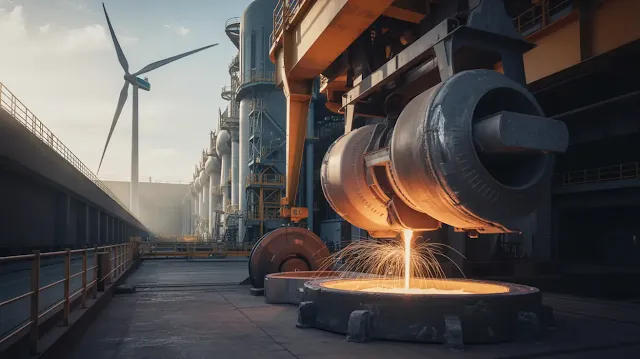Clean Energy in Heavy Industry: Can Manufacturing Go Emission-Free?
Heavy Industry’s Critical Role in the Climate Equation
Heavy industries are often seen as the most challenging to decarbonize due to their high energy demands and reliance on fossil fuels. However, with global climate goals intensifying and green technologies advancing rapidly, key sectors like steel, aluminum, and cement are beginning to shift toward renewable energy sources. This marks a turning point in the global push for sustainability.
Green Aluminum: A Case Study in Renewable Manufacturing
Hydro’s Commitment to Sustainable Smelting
Norwegian aluminum producer Hydro has made a landmark move by securing long-term access to renewable electricity to power its smelters. The company has pledged to reduce carbon emissions significantly by integrating hydropower and biomethane, replacing natural gas in major plants. This initiative positions Hydro as a global leader in low-carbon aluminum production.
Biomethane and Carbon Reduction Goals
Hydro’s pilot projects show the potential to reduce emissions by thousands of tons annually using alternative fuels. Their long-term strategy includes a gradual shift to green hydrogen and carbon capture technologies, with a clear aim to achieve net-zero emissions in the coming years.
Fossil-Free Steel: Sweden Paves the Way
HYBRIT and H2 Green Steel Projects
Sweden has taken center stage in clean steel innovation. The HYBRIT initiative, a collaboration between SSAB, LKAB, and Vattenfall, uses green hydrogen to eliminate fossil fuels from the steel-making process. Similarly, H2 Green Steel is developing a large-scale facility powered entirely by renewables, promising a reduction of carbon emissions by over ninety percent.
Global Impact and Industry Imitation
These pioneering projects are setting a new standard, with countries like Germany and Canada exploring similar hydrogen-based steel production techniques. If adopted globally, these innovations could transform steel into a climate-neutral material.
Cleaner Cement Through Technology and Smart Energy
ABB’s Role in Digital Optimization
Energy giant ABB is helping cement plants reduce their carbon footprint by introducing AI-driven control systems that optimize fuel consumption and improve operational efficiency. These tools allow factories to adjust their energy usage in real-time, slashing emissions without compromising productivity.
Case Study: Solar Cement in Egypt
Arabian Cement, one of Egypt’s largest producers, recently installed the country's biggest industrial solar energy plant, cutting carbon emissions significantly. This highlights the role of solar integration even in energy-intensive sectors like cement.
Government Policies Driving Industrial Clean Energy
China’s Renewable Mandates for Industry
China has introduced new regulations mandating renewable energy targets for major industrial sectors. These include strict quotas for the use of solar and wind energy in aluminum, steel, and cement production. By 2025, regions like Yunnan must meet targets of over seventy percent renewable use in key industries.
Australia’s Funding for Aluminum Smelters
To support its clean energy transition, Australia has launched a multibillion-dollar investment fund to assist aluminum producers in moving toward solar- and wind-powered operations. Companies like Rio Tinto are already benefitting from this initiative, securing green power contracts to run smelters at lower carbon costs.
The Rise of Green Hydrogen and Electrification
Hydrogen as a Clean Industrial Fuel
Green hydrogen is rapidly emerging as the most viable replacement for fossil fuels in high-temperature processes. It’s being deployed in various ways, from iron reduction in steelmaking to fuel substitution in chemical processing.
Electrification of Industrial Equipment
Industries are also shifting to electrically powered motors and machinery, reducing dependence on diesel generators and enabling better integration with renewable microgrids.
Recycling and Circularity: Rethinking Resource Use
Aluminum Recycling and Energy Savings
Recycled aluminum uses only a fraction of the energy required for primary production. Companies are scaling up their aluminum recycling operations under new brand lines, cutting carbon emissions and saving resources while maintaining high-quality output.
Eco-Industrial Parks and Shared Grids
New industrial clusters are being developed with shared renewable grids, allowing multiple factories to benefit from centralized clean energy systems. These eco-parks also promote resource-sharing and waste re-use, creating a closed-loop industrial model.
Overcoming Challenges in Industrial Decarbonization
While progress is accelerating, obstacles remain. These include:
High initial investment costs for hydrogen, solar, and wind infrastructureGrid limitations and storage issues in remote industrial zones
Technological complexity in integrating renewables with legacy systems
Policy uncertainty in global carbon pricing and export rules
To succeed, industries need government incentives, public-private partnerships, and continued innovation funding.
Environmental and Economic Benefits
Reducing Carbon Footprints at Scale
Switching to renewables in heavy industry has a multiplier effect on global emissions reduction. With fewer emissions per ton of output, products like green steel and aluminum become climate-friendly alternatives for construction, transportation, and electronics.
Economic Resilience and Job Creation
Green industrial initiatives also create jobs in engineering, maintenance, R&D, and energy infrastructure. In developing nations, clean factories can improve energy security and reduce reliance on imported fuels.
Conclusion: A Greener Future for Global Industry
The era of fossil-powered heavy industry is fading. As clean energy becomes more affordable and scalable, industries once seen as impossible to decarbonize are becoming testbeds for sustainability. With government support, innovative technologies, and responsible leadership, the vision of carbon-free manufacturing is no longer a distant goal, it’s already underway.
The question is no longer if industry can be green, but how fast we can scale up.




Write a comment, your opinion matters to us